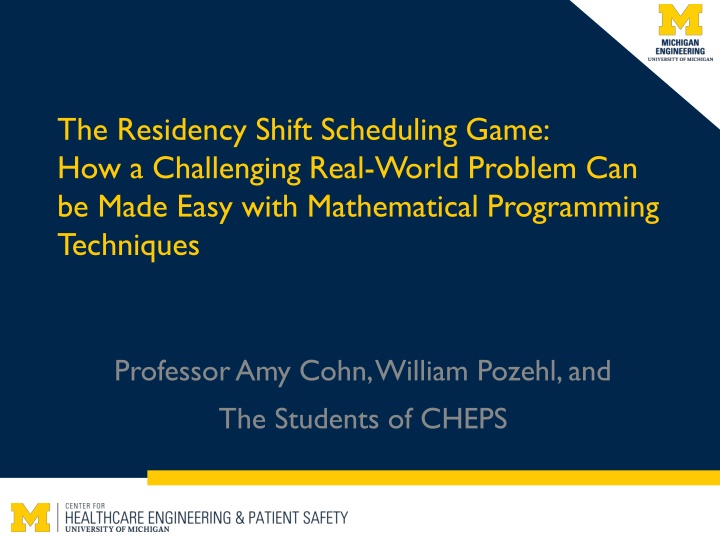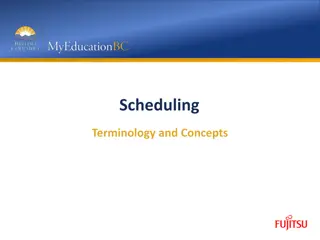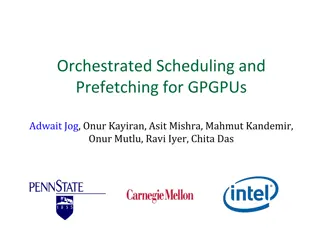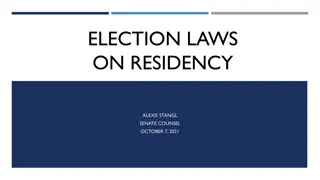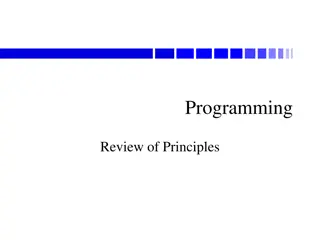Simplifying Residency Shift Scheduling with Mathematical Programming Techniques
This project, led by Professor Amy Cohn and William Pozehl, aims to demonstrate how mathematical programming techniques can simplify the complex task of residency shift scheduling. The Residency Shift Scheduling Game highlights the challenges of manual scheduling and the ease of using mathematical programming for Chief Residents, schedulers, students, and teachers. The initiative sheds light on the transition period of medical residency and the dual role of residents in both learning and patient care.
Download Presentation

Please find below an Image/Link to download the presentation.
The content on the website is provided AS IS for your information and personal use only. It may not be sold, licensed, or shared on other websites without obtaining consent from the author.If you encounter any issues during the download, it is possible that the publisher has removed the file from their server.
You are allowed to download the files provided on this website for personal or commercial use, subject to the condition that they are used lawfully. All files are the property of their respective owners.
The content on the website is provided AS IS for your information and personal use only. It may not be sold, licensed, or shared on other websites without obtaining consent from the author.
E N D
Presentation Transcript
The Residency Shift Scheduling Game: How a Challenging Real-World Problem Can be Made Easy with Mathematical Programming Techniques Professor Amy Cohn, William Pozehl, and The Students of CHEPS
Motivation The purpose of the Residency Shift Scheduling Game, and associated supporting materials, is to show how: 1) a seemingly-straightforward problem can be very difficult to solve by hand 2) such a problem may become much easier to solve by using mathematical programming techniques The game is designed for: 1) Chief Residents and other schedulers solving similar problems by hand, to make them aware of this alternative approach 2) Students (and their teachers) interested in learning ways that mathematics can be used in interesting ways to solve real-world problems 2
Overview Background: What is residency shift scheduling? The Residency Shift Scheduling Game A Brief Introduction to Mathematical Programming Formulating the Residency Shift Scheduling Problem Solving the Residency Shift Scheduling Problem with Open Solver Where to Learn More 3
What is medical residency? Medical residency is a transition period between medical school and fully- independent/unsupervised practice Four years of medical school First year of residency Intern Two or more additional years of residency Possibly one or two additional years as Chief Resident Possibly additional years as a Fellow During all of this time, residents are not only training but also providing patient care, under the oversight of a more senior attending physician (this supervision decreases over time) Undergraduate Student Medical Student Attending Physician Resident Fellow 5
What is medical residency? A key issue: Dual role of residency Learning experience: Residency (and Fellowship) are parts of the medical education training process Patient care: Residents/Fellows provide a significant amount of the patient care in teaching hospitals and the associated clinical system A typical resident might engage in all of the following activities: Shifts on service Continuity clinics (weekly clinical commitments) Seminars, formal educational activities Research 6
Inherent Time Conflicts How to schedule residents time Need adequate patient coverage with a limited pool of residents Need adequate training opportunities Need adequate rest fatigue increases risk of error Need to address resident satisfaction, personal life Not just quantity of hours but pattern Continuity of care Sleep issues (especially associated with overnight shifts) Opportunities for different medical experiences 7
Shift Scheduling Problem Given: a time horizon a set of shifts per day a heterogeneous set of residents Coming from different areas of specialization Having different levels of seniority Assign residents to staff these shifts subject to: every shift needs specific types of coverage residents have limits on when and how often they can work Note that there may be many different schedules that satisfy all of the rules; for this game, we just focus on finding any one feasible schedule, not the best possible schedule. Alternatively, there could be zero schedules that satisfy all of the rules. 8
Why is this hard? Building a schedule by hand is a lot like solving a sudoku puzzle. You can start by individually assigning residents to shifts (like numbers to squares) but The more squares you fill in, the fewer choices you have left for what is valid When you make a mistake, you might not know it for a long time Once you realize something is wrong, it can be very hard to back track and correct 9
The Residency Shift Scheduling Game 10
Playing the Residency Shift Scheduling Game To enable you to develop a better appreciation for the challenges of building a residency shift schedule by hand, we have created a simple Excel-based game to let you experience the Chief Residents challenges Go to https://cheps.engin.umich.edu/tools/shift- scheduling-game/ and click on the link to download the Excel Spreadsheet. You can either follow the instructions in the spreadsheet or, for more detail, play the video also found at this website. At this point, you don t need to download OpenSolver. Try it out! Were you able to build a schedule easily? When you tested it, was your schedule error-free? 11
A Brief Introduction to Mathematical Programming 12
Basic Intro to Mathematical Programming An alternative approach to solving the Residency Shift Scheduling Problem by hand is to solve it using mathematical programming techniques These are linear algebra-based tools that allow a computer to quickly evaluate a very large number of combinations of decisions (far more than a human ever could), both determining if they satisfy a set of rules and also comparing their quality 13
What is an optimization problem? An optimization problem is defined by: A set of decisions to be made Here, a decision is any question that can be answered with a number or yes/no A well-defined set of candidate choices for each decision Clearly-defined rules governing which combinations of decisions are feasible A metric that allows us to compute and compare the values of different sets of decisions 14
Mathematical Programming We can often represent an optimization problem as a mathematical program where we map: Decisions to variables Each decision should be thought of as a question that can be answered by a single number Rules to constraints Metrics to an objective function 15
Example Optimization Problem The Diet Problem: Given a collection of foods, determine how much of each food to eat in a given day Goal is to minimize cost of the diet Have to satisfy rules limiting our choices relative to nutritional content 16
Problem Statement Minimize the cost of my diet (i.e. how much I spend), subject to satisfying lower bounds on protein and taste, and upper bounds on calories and fat What are the decisions, goal, and rules? 17
The Diet Problem, cont. Goal: Minimize cost Rules: Lower limit on protein Lower limit on taste Upper limit on calories Upper limit on fat content Decisions: How much: Chocolate Special K Liver Orange juice Pizza 18
Map Decisions to Variables Variables: Each variable represents the answer to a question. For example, xcanswers the question How much chocolate should I include in my diet? 19
Map Goal to Objective Function Objective: Minimize (cc,ck, cl, co, and cp are parameters.) If ck represents the cost per unit of Special K cereal, then ck xk represents the total amount that you choose to spend on Special K, given that you decided to include xk units of Special K in your diet 20
Map Rules to Constraints Subject to: (pc,pk, pl, po, and pp are parameters.) If pl represents the amount of protein in one unit of liver, then pl xlrepresents the total amount of protein you ll get from the liver you ve decided to include in your diet. The sum of these terms across all foods in your diet must be at least the lower bound on how much protein you need (P). 21
Mathematical Program Objective: Subject to: Variables: 22
Formulating the Residency Shift Scheduling Problem 23
Formulating the Residency Shift Scheduling Problem Decisions: For each shift, which resident to assign Rules: Every shift needs a resident Every resident needs between 12 and 16 shifts Every resident needs between 2 and 5 night shifts Every resident needs adequate rest (10 hours) between shifts Interns cannot work the first or last shift of the day Every resident has a day of week he or she cannot work Goal: For this version of the problem, any fully-feasible solution will do (in practice, it gets a lot more complicated!) 24
Formulating the Residency Shift Scheduling Problem What is our variable definition? Does resident r get assigned to shift s on day d, yes or no? We have one such variable for every combination of resident r/shift s/day d A problem with 16 residents and 7 shifts per day in a 30-day month will therefore require 16*7*30 = 3360 variables 25
Formulating the Residency Shift Scheduling Problem Every shift needs a resident: For each shift, we will have a separate constraint The constraint states that, across all residents, exactly one must be chosen for all shifts s and all days d The summation notion says Add up across all residents . If there are 16 residents with 7 shifts per day in a 30 day month, there would be 7*30 = 210 constraints of this form and each would include 16 variables, one for each resident 26
Formulating the Residency Shift Scheduling Problem Every resident needs between 12 and 16 shifts: For each resident, we will have a separate constraint This constraint will sum all of the shifts assigned to that resident and constrain this sum to be between 12 and 16 for all residents r If we have 16 residents, then we ll have 32 constraints of this type (one > and one < for each resident), and each of these constraints will include 7*30 variables 27
Formulating the Residency Shift Scheduling Problem Every resident needs between 2 and 5 night shifts: For each resident, we will have a separate constraint This constraint will sum all of the shifts that are classified as night shifts assigned to that resident and constrain this sum to be between 2 and 5 for all residents r If we have 16 residents, then we ll have 32 constraints of this type (one > and one < for each resident), and each of these constraints will include 7*30 variables 28
Formulating the Residency Shift Scheduling Problem Every resident needs adequate rest (10 hours) between shifts: For each resident, day, and shift we will have a separate constraint This constraint will sum a shift (xrsd) and the set of shifts that are incompatible with this shift (because they begin within 10 hours of this shift ending) incompatible with shift s on day d due to the ten-hour rule A problem with 16 residents and 7 shifts per day in a 30-day month will therefore require 16*7*30 = 3360 constraints of this form for all residents r, days d, and shifts s, where Lsd is the set of shifts that are 29
Formulating the Residency Shift Scheduling Problem Interns cannot work the first or last shift of the day: For each of these shifts, all residents of type intern are not allowed as candidate choice A problem with 8 interns and 2 constraints each, yields 16 constraints of this type for all rof type intern for all rof type intern 30
Formulating the Residency Shift Scheduling Problem Each resident has a specific day of week he or she cannot work, Dr is the set of corresponding days in the month For each for all r in R, s in S, d in Dr A problem with 16 residents (each with one day they cannot work) yields 448 constraints of this type 31
Formulating the Residency Shift Scheduling Problem Total problem size: 3360 binary variables 4098 constraints 32
Solving the Residency Shift Scheduling Problem Using OpenSolver 33
Solving the Mathematical Program In a mathematical program, sets of decisions and their interactions with each other can be represented by a series of mathematical equations. Algorithms can then be used to solve these equations and explore the associated set of feasible solutions in very effective ways For problems like the residency shift scheduling problem presented here, OpenSolver, an add-on to Microsoft Excel, can solve these problems quite quickly To install OpenSolver and try it yourself, or to study the model in greater detail, you can find additional resources here: https://cheps.engin.umich.edu/tools/shift-scheduling-game/ 34
Where to Learn More If you found this interesting and would like to learn more about: collaborating with the Center for Healthcare Engineering and Patient Safety (CHEPS) at the University of Michigan to develop tools for your own residency program using this game in your high school, college, or medical school classroom or having someone from CHEPS come to give a guest lecture studying healthcare engineering at CHEPS helping us to improve the game and associated materials Please contact us as cheps-contact@umich.edu or go to https://cheps.engin.umich.edu/ . 36
